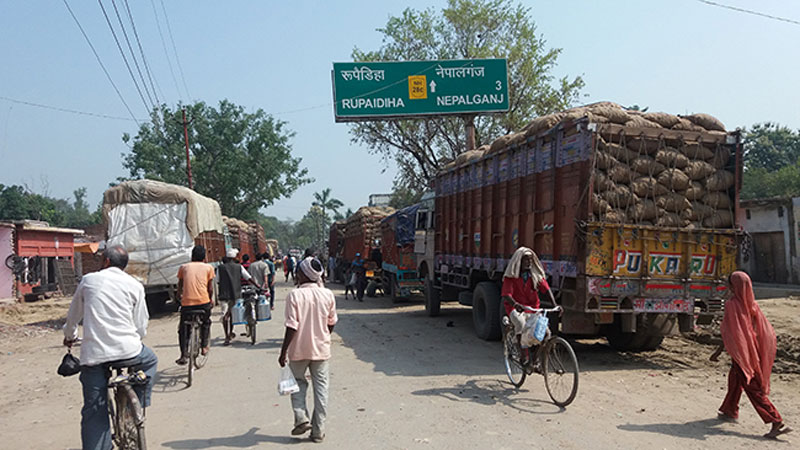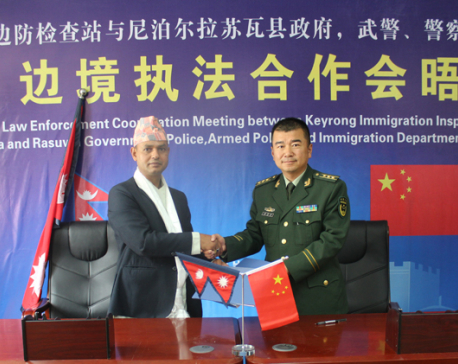
OR

More from Author
It is precisely because the border is unregulated that there are so many border disputes between Nepal and India
A state has a defined territory. Borders are indispensable to preserve national sovereignty. If we abolish borders, our country will cease to exist, as simple as that. Open borders do not mean that borders are irrelevant. Even with an open border, the border remains intact and the two nations retain jurisdiction over their respective territories. In Europe, citizens in the countries in the European Union are free to crisscross national borders. Every day, thousands of Italians, for example, cross the border into France, and vice versa. Their borders haven’t disappeared, and Italy and France are still sovereign.
The newly elected US President Donald Trump wants to build a wall on the American border with Mexico as more than 90 percent of heroin in American markets comes from traffickers across the southern border. Around 25 percent of inmates in US federal prisons are criminal aliens and at least 39 percent of human-induced wildfires in the American border state of Arizona are suspected to have been ignited by those illegally crossing US-Mexico border. And the two countries don’t even have an open border! But what if they had an open border like the one between Nepal and India?
Article 7 of the Treaty of Peace and Friendship between India and Nepal signed in Kathmandu on July 31, 1950 states that “the Governments of India and Nepal agree to grant, on a reciprocal basis, to the nationals of one country in the territories of the other the same privileges in the matter of residence, ownership of property, participation in trade and commerce, movement and other privileges of a similar nature”. This article gives Indian nationals nearly as many privileges in Nepal as Nepal accords to its own citizens, and vice-versa, including the right to own property.
The Tarai-Madhesh, with only with 23.1 percent of the total land area of the Nepal is home to over 50 percent of its people. The population of Tarai was 35.2 percent of total population in 1952/54, which increased to 48.4 percent by 2001 and to 50.27 percent by 2011. The Nepalese Citizenship Act 2063 explicitly mentions that Nepal may grant naturalized citizenship to foreign citizens who have resided in Nepal for a minimum 15 years. The question here is whether the population of Tarai has been increasing so fast due to the open border.
The other important question is whether the open border abets evasion of custom duties and provides escape route for criminals.
A 2012 joint research of the Kathmandu School of Law and the American Bar Association in 13 districts including Kathmandu, Lalitpur, Kkanchanpur, Kailali and Banke showed that of 70 human trafficking cases from these districts, 51 involved cross-border movements.
According to the Department of Prison Management (DoPM), the number of foreigners in Nepali jails was 850 as of August 2015, with 614 of them Indian citizens. Most Indian and Bhutanese prisoners in Nepali jails were convicted of drug smuggling, robbery, murder and human trafficking. Thus it might be argued that the open border has led to an increase in crimes in Nepal. That is not all.
According to Asian Development Bank, 21.9 percent population in India lives below the poverty line.
In absolute numbers, this comes to many times the population of Nepal. The population of Bihar alone was nearly 100 million as per the 2011 census. The data of Reserve Bank of India show that 32.6 percent of population in Bihar lives below the poverty line. In other words, there are more poor people in Bihar than there are people in Nepal. And poverty is one of the biggest causes for crimes.
Open border between Nepal and India, in this light, can be seen as a boon for criminals from the two countries.
Also, Article 8 of Treaty of Peace and Friendship cancels all previous treaties, agreements and arrangements between the British Government and the Government of Nepal. Does this mean that territorial demarcations that were made before that time are invalid? If so, the territorial integrity of Nepal will be directly challenged.
Cartographer Buddhi Narayan Shrestha says there are 71 disputed areas along the 1,880-km Nepal-India border. Of the 26 districts abutting India, there are border disputes in 23 districts and the total of such disputed area comes to 606.62 square kilometer. For instance, India has apparently encroached around upon 370 sq km of Kalapani-Limpiyadhura area of Darchula district and 145 sq km of Susta area of Nawalparasi district. Nor is this just an issue between Nepal and India.
Nepal is not a party to the 1951 UN Refugee Convention and it was as such not obliged to accept Bhutanese or other refugees from third-countries. However Nepal was forced to give shelter to over 100,000 Bhutanese refugees when India directed the flow of refugees who were fleeing Bhutan for India into Nepal. India would not have been able to send us so many refugees if we had a more regulated border with it.
It is precisely because the border is unregulated that there have been so many border disputes between Nepal and India. It is because there is no border patrolling nor are there proper fences and demarcations. If the current rate of encroachment of Nepali territories by India continues, Nepalis might soon discover that huge swathes of what they refer to as Nepal might have already gone to India.
Moreover, it is not only petty criminals who are thriving on border regions. India has always been on high alert about the prospect of terrorists exploiting the open Indo-Nepal border.
It is clear that South Asia, with its plethora of problems like human trafficking and terrorism, is not a suitable place for open borders. Thus time has come to better regulate Indo-Nepal border. The border must be better fenced and better patrolled. There must be a passport system so that there is a record of each and every person who crosses Indo-Nepal border, either way. For this we need a thorough revision of the Treaty of Peace and Friendship.
The author is a fifth year student of BA LLB at Kathmandu School of Law
sangamissangroula@gmail.com
You May Like This

Security beefed up in border areas ahead of elections
DANG, Dec 3: With the objective of conducting peaceful and systematic elections, security has been beefed up along Indo-Nepal border in... Read More...

Nepal, China seal border security deal
KATHMANDU, July 7: The Nepal government and China government have agreed to establish Nepal-China Border Law Enforcement Cooperation (Keyrong) Joint... Read More...

Protests continue against border delineation of Province 5
KATHMANDU, Dec 19: Protests against the government's move to revise federal boundaries of Province 5 have paralyzed various districts of... Read More...




Just In
- Fixing a win by outlawing dissent damages democracy
- MoHP cautions docs working in govt hospitals not to work in private ones
- Over 400,000 tourists visited Mustang by road last year
- 19 hydropower projects to be showcased at investment summit
- Global oil and gold prices surge as Israel retaliates against Iran
- Sajha Yatayat cancels CEO appointment process for lack of candidates
- Govt padlocks Nepal Scouts’ property illegally occupied by NC lawmaker Deepak Khadka
- FWEAN meets with President Paudel to solicit support for women entrepreneurship








_20220508065243.jpg)





Leave A Comment